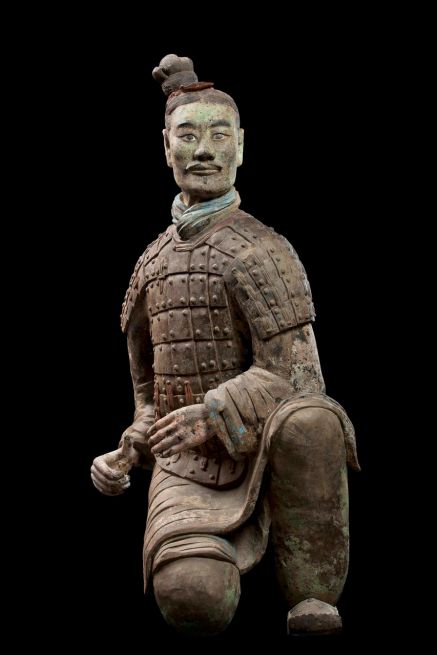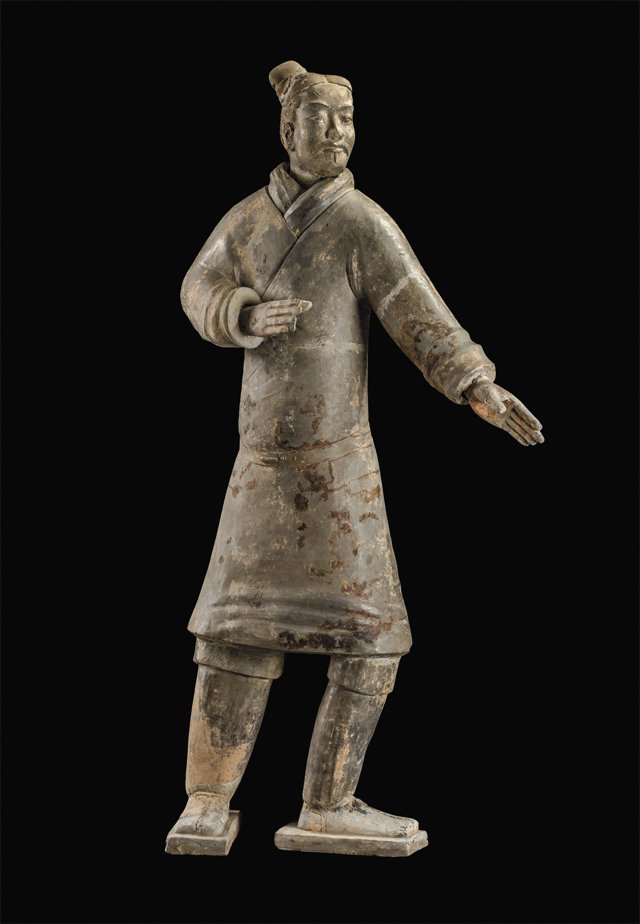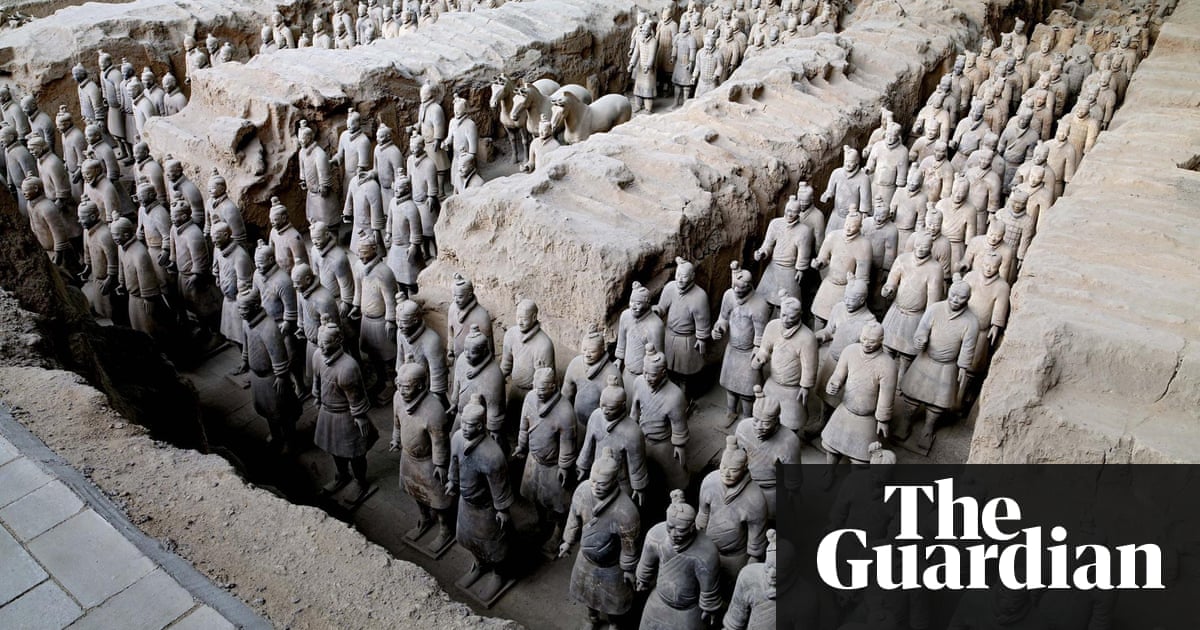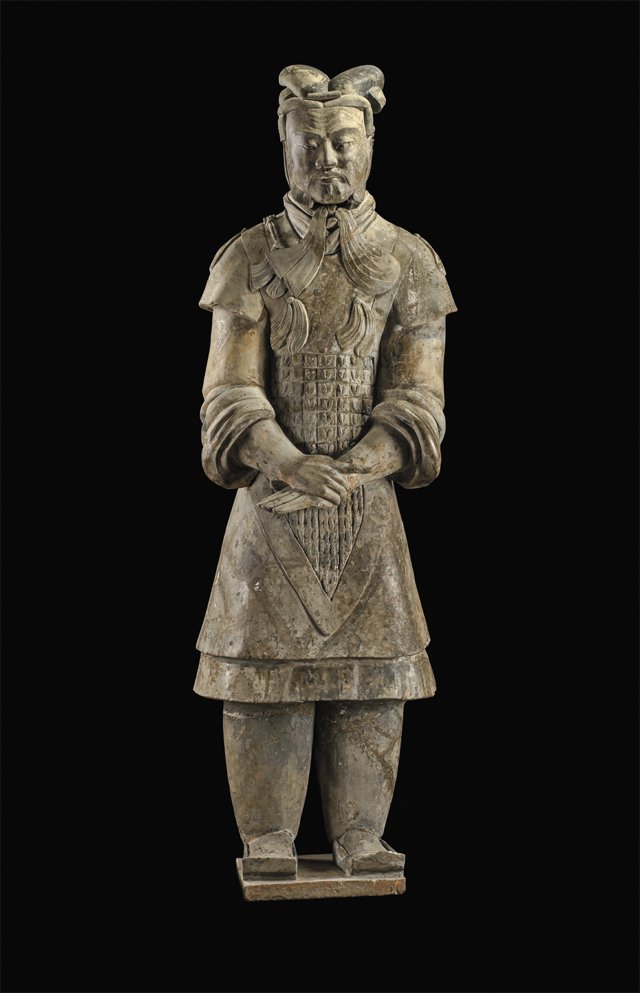Cincinnati Art Museum
April 20 through August 12, 2018
First discovered in 1974 by farmers in China, an underground army of nearly 8,000 life-size terracotta figures is known as one of the greatest archaeological finds of the 20th century. Discovered one mile east of the known burial site of the First Emperor of China (r. 221–210 BC), or Qin Shihuang, the terracotta army was created to accompany the emperor to the afterlife. This exhibition features ten majestic terracotta figures, including a cavalry horse, among 130 works that tell the story of China’s birth and one man’s lasting imprint on a nation.
The exhibition also features arms and armor, horse and chariot fittings, ritual bronze vessels, works in gold and silver, jade ornaments, precious jewelry, and ceramics. Excavated from the First Emperor’s mausoleum complex, as well as aristocratic and nomadic tombs, the objects date from the Eastern Zhou dynasty (770–256 BC) through the Qin dynasty (221–206 BC) and represent the complex history, myths, and burial customs of ancient China. They also explore the First Emperor’s profound influence on Chinese history.

April 20 through August 12, 2018
First discovered in 1974 by farmers in China, an underground army of nearly 8,000 life-size terracotta figures is known as one of the greatest archaeological finds of the 20th century. Discovered one mile east of the known burial site of the First Emperor of China (r. 221–210 BC), or Qin Shihuang, the terracotta army was created to accompany the emperor to the afterlife. This exhibition features ten majestic terracotta figures, including a cavalry horse, among 130 works that tell the story of China’s birth and one man’s lasting imprint on a nation.
The exhibition also features arms and armor, horse and chariot fittings, ritual bronze vessels, works in gold and silver, jade ornaments, precious jewelry, and ceramics. Excavated from the First Emperor’s mausoleum complex, as well as aristocratic and nomadic tombs, the objects date from the Eastern Zhou dynasty (770–256 BC) through the Qin dynasty (221–206 BC) and represent the complex history, myths, and burial customs of ancient China. They also explore the First Emperor’s profound influence on Chinese history.

Kneeling Archer, Qin dynasty (221–206 BC), earthenware, Excavated from Pit 2, Qin Shihuang’s Mausoleum, 1977, Emperor Qin Shihuang’s Mausoleum Site Museum
The formation and vast influence of China’s landmark Qin dynasty
will be showcased in Terracotta Army: Legacy of the First Emperor of China from
April 20 through August 12, 2018.
This special exhibition includes 120 objects drawn from the collections of Chin ese art museums and archaeological institutes. More than 40 of these works have never been on view in the U.S. before this exhibition. Expanding upon previous exhibitions, Terracotta Army not only includes the impressive terracotta figures, but also consi ders important works of art from the Qin's neighboring states and tells the story of the nomadic peoples of northwestern China.
Dating from 770 - 206 B.C., these works of art, excavated from the emperor’s mausoleum as well as aristocratic and nomadic tombs, richly reflect history, myths and burial practices in ancient China. In addition to the nine life - size terracotta figures, the exhibition includes a cavalry horse, arms and armor, ritual bronze vessels, works in gold and silver, jade ornaments, precious jewelry and ceramics.
“This international exchange is a momentous occasion for our museum and the Greater Cincinnati region. The original scholarship supporting the exhibition and the opportunity for Cincinnati to learn about the legacy of the First Emperor will be a revelation to every visitor to the museum. We are proud to showcase the splendor of the art and history of China through our ambitious par tnership with Shaanxi Province ,” said Cameron Kitchin, Cincinnati Art Museum’s Louis and Louise Dieterle Nippert Director.

The Cincinnati Art Museum co - organized the exhibition with the Virginia Museum of Fine Arts (VMFA), where it make s its debut from No v ember 18, 2017 to Mar ch 11, 2018. The exhibition is presented in partnership with Shaanxi Provincial Cultural Relics Bureau, Shaanxi History Museum (Shaanxi Cultural Heritage Promotion Center), and Emperor Qin Shihuang’s Mausoleum Site Museum of the People’s Republic of China.
Dr. Hou - mei Sung, Curator of Asian Art at the Cincinnati Art Museum, curated the exhibition with Li Jian, the VMFA’s E. Rhodes and Leona B. Carpenter Curator of East Asian Art.
Terracotta Army’s story begins with Ying Zheng (259 - 210 B.C.), who became the first emperor of China in 221 B.C., after his army defeated other regional states and unified the country. After coming to power, he implemented fundamental cultural, political and economic reforms and established China’s core territory.
In 1974 local farmers digging a well outside the city of Xi’an in Shaanxi province, China, discovered pottery shards and bronze arrows near the mausoleum of Ying Zheng.



This led to the astonishing discovery of 8,000 life - size terracotta warriors and horses , which is considered one of the most important archaeological finds in human history. The mausoleum was named a UNESCO World Heritage Site in 1987.
This special exhibition includes 120 objects drawn from the collections of Chin ese art museums and archaeological institutes. More than 40 of these works have never been on view in the U.S. before this exhibition. Expanding upon previous exhibitions, Terracotta Army not only includes the impressive terracotta figures, but also consi ders important works of art from the Qin's neighboring states and tells the story of the nomadic peoples of northwestern China.
Dating from 770 - 206 B.C., these works of art, excavated from the emperor’s mausoleum as well as aristocratic and nomadic tombs, richly reflect history, myths and burial practices in ancient China. In addition to the nine life - size terracotta figures, the exhibition includes a cavalry horse, arms and armor, ritual bronze vessels, works in gold and silver, jade ornaments, precious jewelry and ceramics.
“This international exchange is a momentous occasion for our museum and the Greater Cincinnati region. The original scholarship supporting the exhibition and the opportunity for Cincinnati to learn about the legacy of the First Emperor will be a revelation to every visitor to the museum. We are proud to showcase the splendor of the art and history of China through our ambitious par tnership with Shaanxi Province ,” said Cameron Kitchin, Cincinnati Art Museum’s Louis and Louise Dieterle Nippert Director.

"Standing Archer," Qin dynasty (221-206 BC), earthenware. Excavated from Pit 2, Qin Shihuang’s Mausoleum, 1997. © Emperor Qin Shihuang’s Mausoleum Site Museum. (Photo courtesy Virginia Museum of Fine Arts)
The Cincinnati Art Museum co - organized the exhibition with the Virginia Museum of Fine Arts (VMFA), where it make s its debut from No v ember 18, 2017 to Mar ch 11, 2018. The exhibition is presented in partnership with Shaanxi Provincial Cultural Relics Bureau, Shaanxi History Museum (Shaanxi Cultural Heritage Promotion Center), and Emperor Qin Shihuang’s Mausoleum Site Museum of the People’s Republic of China.
Dr. Hou - mei Sung, Curator of Asian Art at the Cincinnati Art Museum, curated the exhibition with Li Jian, the VMFA’s E. Rhodes and Leona B. Carpenter Curator of East Asian Art.
Terracotta Army’s story begins with Ying Zheng (259 - 210 B.C.), who became the first emperor of China in 221 B.C., after his army defeated other regional states and unified the country. After coming to power, he implemented fundamental cultural, political and economic reforms and established China’s core territory.
In 1974 local farmers digging a well outside the city of Xi’an in Shaanxi province, China, discovered pottery shards and bronze arrows near the mausoleum of Ying Zheng.



This led to the astonishing discovery of 8,000 life - size terracotta warriors and horses , which is considered one of the most important archaeological finds in human history. The mausoleum was named a UNESCO World Heritage Site in 1987.
Significantly, the exhibition considers the relationship
between the first emperor’s Qin dynasty (221 - 206 B.C.) and other peoples,
exploring their distinctive artistic styles and fostering an appreciation of
diverse cultures. The exhibition also provides a glimpse into ongoing
excavations and research, which continue to shed new light on the Qin culture
and th e First Emperor’s burial complex.
“I believe this exhibition will provide a great opportunity for American audiences to understand the daily life of Qin people and the visual culture of the empire more than 2,000 years ago. This exhibition actively promote s cultural exchange between China and the United States, and increases understanding and friendship between peoples of both nations,” said Dr. Zhao Rong, Director of the Shaanxi Provincial Cultural Relics Bureau.


A major scholarly catalogue titled Terracotta Army: Legacy ofthe First Emperor of China accompanies the exhibition. It includes contributions from the curators and other scholars and features new scholarship and research based on recent excavations.
“I believe this exhibition will provide a great opportunity for American audiences to understand the daily life of Qin people and the visual culture of the empire more than 2,000 years ago. This exhibition actively promote s cultural exchange between China and the United States, and increases understanding and friendship between peoples of both nations,” said Dr. Zhao Rong, Director of the Shaanxi Provincial Cultural Relics Bureau.

Armored General, Qin Dynasty (221–206 BC), earthenware. Excavated from Pit 1, Qin Shihaung’s Mausoleum, 1977. (© Emperor Qin Shihaung’s Mausoleum Site Museum)

A major scholarly catalogue titled Terracotta Army: Legacy ofthe First Emperor of China accompanies the exhibition. It includes contributions from the curators and other scholars and features new scholarship and research based on recent excavations.
https://www.vmfa.museum/exhibitions/wp-content/uploads/sites/7/2016/09/TerracottaGoogle.jpg
No comments:
Post a Comment